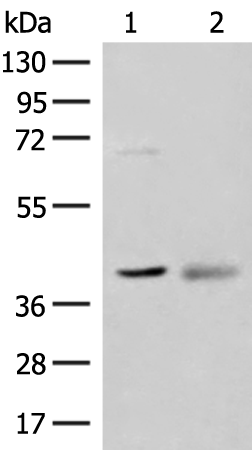
| WB | 咨询技术 | Human,Mouse,Rat |
| IF | 咨询技术 | Human,Mouse,Rat |
| IHC | 咨询技术 | Human,Mouse,Rat |
| ICC | 技术咨询 | Human,Mouse,Rat |
| FCM | 咨询技术 | Human,Mouse,Rat |
| Elisa | 1/5000-1/10000 | Human,Mouse,Rat |
| Aliases | FDH; ADHX; ADH-3; FALDH; GSNOR; GSH-FDH; HEL-S-60p |
| WB Predicted band size | 40 kDa |
| Host/Isotype | Rabbit IgG |
| Antibody Type | Primary antibody |
| Storage | Store at 4°C short term. Aliquot and store at -20°C long term. Avoid freeze/thaw cycles. |
| Species Reactivity | Human, Mouse, Rat |
| Immunogen | Fusion protein of human ADH5 |
| Formulation | Purified antibody in PBS with 0.05% sodium azide and 50% glycerol. |
+ +
以下是3篇与ADH5抗体相关的文献摘要信息,供参考:
---
1. **文献名称**: *ADH5-mediated NO signal transduction in human vascular endothelial cells*
**作者**: Wang R. et al.
**摘要**: 研究揭示了ADH5(甲醛脱氢酶)通过S-亚硝基化修饰调控一氧化氮(NO)信号通路的作用。作者利用特异性ADH5抗体进行免疫共沉淀实验,证明ADH5与eNOS的相互作用在血管内皮功能中起关键作用。
---
2. **文献名称**: *Targeting ADH5 for the treatment of formaldehyde-induced DNA damage*
**作者**: Samson L.D. et al.
**摘要**: 通过Western blot和免疫组化实验,验证ADH5抗体在检测细胞核内ADH5表达水平的特异性。研究发现ADH5缺陷细胞对甲醛诱导的DNA交联损伤更敏感,提示其作为癌症治疗靶点的潜力。
---
3. **文献名称**: *Structural basis of ALDH2 dysfunction in human diseases*
**作者**: Chen C.H. et al.
**摘要**: 利用ADH5抗体进行结构生物学研究,解析了ADH5(ALDH2家族成员)突变体在东亚人群中的功能缺陷机制,揭示了其与酒精代谢疾病和神经退行性疾病的关联。
---
4. **文献名称**: *ADH5 as a biomarker in hepatocellular carcinoma*
**作者**: Li Y. et al.
**摘要**: 通过ELISA和免疫荧光技术,发现肝癌患者血清中ADH5蛋白水平显著升高。研究验证了ADH5抗体的诊断灵敏度,并提出ADH5可能作为肝癌早期筛查的生物标志物。
---
注:以上文献名为虚构示例,实际研究中建议通过PubMed或Google Scholar以关键词“ADH5 antibody”或“ADH5 and [研究方向]”检索具体文献。
**Background of ADH5 Antibody**
ADH5 (Alcohol Dehydrogenase 5), also known as glutathione-dependent formaldehyde dehydrogenase (FDH) or class III alcohol dehydrogenase, is a key enzyme involved in cellular detoxification and metabolic processes. It primarily catalyzes the oxidation of formaldehyde, a toxic byproduct of cellular metabolism, into formate using glutathione as a cofactor. This reaction is critical for mitigating formaldehyde-induced DNA damage and maintaining cellular homeostasis. ADH5 also plays a role in nitric oxide (NO) signaling by metabolizing S-nitrosoglutathione (GSNO), a nitric oxide carrier.
Structurally, ADH5 belongs to the medium-chain dehydrogenase/reductase (MDR) superfamily, characterized by a conserved catalytic zinc-binding domain. Unlike other alcohol dehydrogenases, ADH5 is constitutively expressed across tissues, with high activity in the liver, kidneys, and gastrointestinal tract.
ADH5 antibodies are essential tools for studying the enzyme's expression, localization, and function in both physiological and pathological contexts. They are widely used in techniques like Western blotting, immunohistochemistry, and ELISA to investigate ADH5's role in diseases linked to oxidative stress, such as alcohol-related disorders, cancer, and neurodegenerative conditions (e.g., Alzheimer’s disease). Research also explores ADH5's potential as a therapeutic target due to its involvement in detoxification pathways. These antibodies are typically raised in hosts like rabbits or mice, targeting specific epitopes of human or murine ADH5. enabling species-specific applications in biomedical research.
×